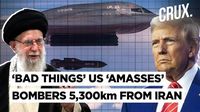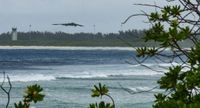In a significant military maneuver, the United States has deployed four long-range B-2 stealth bombers to Diego Garcia, an Indian Ocean base strategically positioned far from the reach of Yemen's Iran-backed Houthi rebels. This move, confirmed by satellite imagery on March 29, 2025, underscores the U.S. commitment to intensifying its airstrike campaign against the Houthis, who have been a persistent threat in the region.
The B-2 bombers, known for their stealth capabilities and nuclear potential, were previously stationed at various locations but have now been consolidated at Diego Garcia, a base that allows them to operate without relying on allied bases in the Middle East. This strategy not only enhances operational security but also extends the reach of U.S. air power in a volatile region.
According to an analysis by the Associated Press, the deployment of these bombers marks a notable escalation in U.S. military involvement in the ongoing conflict in Yemen. The Biden administration has previously utilized B-2 bombers with conventional munitions against Houthi targets, indicating a shift towards a more aggressive stance in response to the group’s actions.
As of this week, three B-2 bombers were already confirmed at the base, with the fourth arriving shortly thereafter. This means that a quarter of the U.S. nuclear-capable B-2 fleet is now positioned at Diego Garcia, which could potentially serve as a launch point for strikes not only against the Houthis but also against other regional threats, including Iran.
The strategic significance of this deployment cannot be overstated. The base at Diego Garcia is located far outside the range of Houthi missile capabilities, providing a safe staging area for U.S. forces. This allows the military to conduct operations with reduced risk of retaliation from the Houthis, who have been known to target U.S. interests in the region.
In addition to the B-2 bombers, the USS Harry S. Truman aircraft carrier has been actively launching attacks against Houthi positions from the Red Sea. The U.S. Navy is also planning to bring the USS Carl Vinson carrier to the Middle East from Asia, further bolstering its naval presence in the region. This combination of air and naval power illustrates a comprehensive approach to countering Houthi aggression and maintaining stability in the area.
The escalation of military operations comes amid ongoing tensions in the Middle East, where the Houthis have launched numerous attacks against Saudi Arabia and other regional players. Their actions have prompted a coordinated response from the U.S. and its allies, aiming to curtail the influence of Iran and its proxies in the region.
Analysts suggest that the deployment of B-2 bombers could serve as a deterrent to further Houthi aggression, signaling that the U.S. is prepared to take decisive action if necessary. The presence of these bombers, coupled with the naval assets in the area, sends a clear message to both the Houthis and Iran regarding the U.S. commitment to protecting its interests and those of its allies.
As the situation continues to evolve, the international community is closely monitoring the developments in Yemen and the broader implications for regional security. The U.S. military's actions reflect a strategic recalibration in response to the changing dynamics of the conflict, with a focus on ensuring that the balance of power remains favorable to U.S. interests.
In conclusion, the recent deployment of B-2 bombers to Diego Garcia represents a significant escalation in U.S. military involvement in Yemen, highlighting the ongoing conflict's complexity and the necessity for robust military readiness in the face of regional threats. As the U.S. continues its airstrikes against the Houthis, the implications of this military strategy will be felt far beyond the immediate conflict, shaping the geopolitical landscape of the Middle East for years to come.



